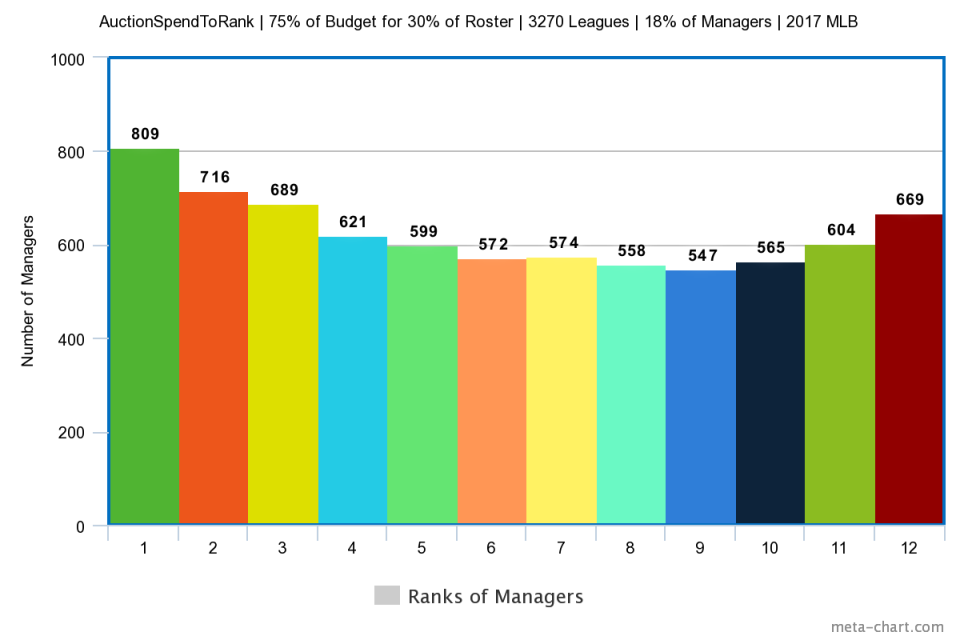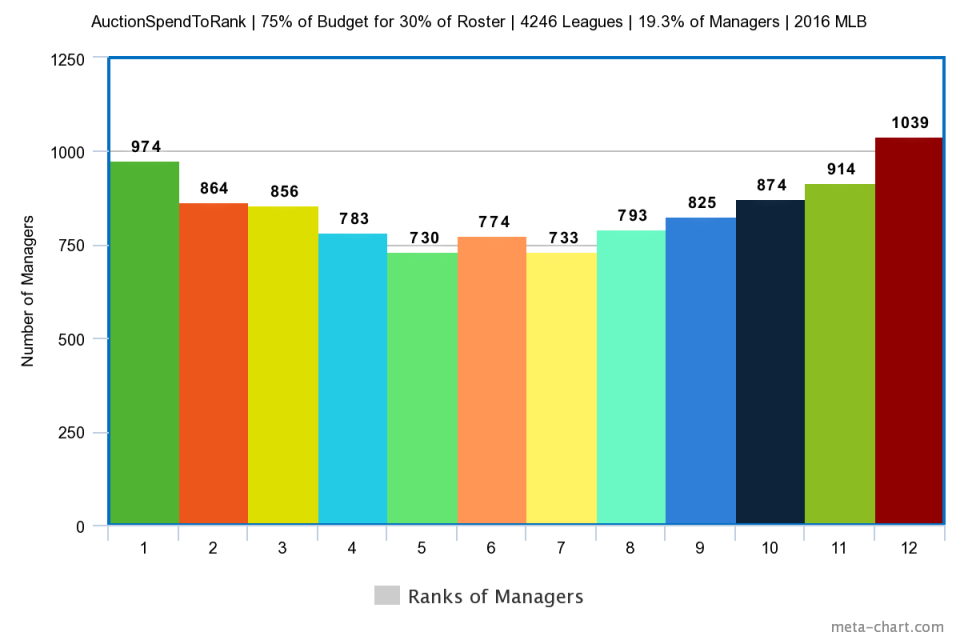Dissecting volatility of 'stars and scrubs' Fantasy Baseball auction strategy

Stars are increasingly on the horizon for those seeking to navigate toward a Fantasy Baseball championship. And, in Yahoo auction leagues, that of course also means having “scrubs” on your team to be able to fit the studs in your budget.
In 2017, devoting 75% of your budget to 30% of your roster (or let’s call it $195 on your top seven players) was a winning strategy on balance (note data pulled from the game by intern Gordon Duzhou). About 18% of managers in the bucket opted for this strategy and a plurality, 24.7%, finished in first place. And the second-greatest number of owners finished in second place and third-most in third. However, evidence of the highly volatile nature of this “stars and scrubs” strategy is that the fourth-most owners finished in last place.

This continues a three-year trend where this strategy has become increasingly optimal. In 2016, 19.3% of managers in the bucket tried this and while most (24.4%) finished in last place, first place (22.9%) was the second most-frequent outcome. That was a big departure from 2015 when the most likely outcome for the teams employing stars-and-scrubs was last place (24.4%) with first place being least likely (14.9%).

As with any strategy, who you pick and not how you pick is most important. But in auctions, you simply have to pass on the top 10 to about 25 players if you are devoted to spreading the risk by spreading your money more evenly among your entire 23-man roster.
Generally, the more shallow your league, the more attractive it is to pay for premium players, resulting in the type of top-heavy roster described above. The reason is that the replacement level on the waiver wire is generally high. So “stars and scrubs” should be your default strategy in all 10-team mixed leagues and is generally advisable even in 12-team, mixed formats assuming there are severe limits to disabled slots and non-active players and, of course, shorter (five-man or less) benches. But even with these roster rules, a spread-the-risk strategy becomes much more advisable in 15-team mixed leagues and all AL- or NL-only leagues consisting of at least 10 teams.
Generally, I have found that winning teams have about seven players providing the majority of surplus value with the rest of the roster merely contributing average or even slightly-below-average statistic value. This is relative to the hitting or pitching roster spot they occupy. So just buying seven great players in a shallow format increases the chances that you meet your allotment of true difference makers. But in deeper formats, doing this while buying with your depleted funds the “hold-the-fort” guys becomes an impossible challenge for all but the most-savvy owners.
These players are really expensive in auctions because there is a very limited supply of stars. Last year, when the strategy was winning, the 10 highest-paid players in Yahoo auctions were in order Mike Trout, Kris Bryant, Nolan Arenado, Mookie Betts, Jose Altuve, Manny Machado, Clayton Kershaw, Paul Goldschmidt, Bryce Harper and Josh Donaldson.
Yes, Trout, Kershaw, Harper and Donaldson missed games but not one of these guys was a flat-out bust especially in 12-team mixed leagues where you more easily replace them with something serviceable on the waiver wire. Even average acumen with this “free loot,” as Rotoman Peter Kreutzer has called it, provided outstanding returns for the roster spot when combined with any of those injured stars.
[Yahoo Fantasy Football leagues are open: Sign up now for free]
This year, the 10 highest paid payers were Trout ($56.5), Altuve ($54.7), Arenado ($51.4), Trea Turner ($49.5), Kershaw ($49.1), Betts ($47.5), Harper ($46.3), Giancarlo Stanton ($46.2), Goldschmidt ($46.2) and Charlie Blackmon ($46). Thus far, only Trout and Betts have provided anywhere near expected returns. But of course it’s far too early to say the stars-and-scrubs this year will be a bust.
Ironically, stars and scrubs is looking like a winning strategy because of the scrubs. Among the highest earning players through Monday, according to our friends at TG Fantasy Baseball, are some auction afterthoughts. Jed Lowrie is earning almost 50% more than Altuve at second base. Christian Villanueva and Asdrubal Cabrera are each crushing Arenando. Mitch Haniger is out-earning even Mike Trout, never mind the suddenly slumping Bryce Harper (who, to be clear, does not yet remotely qualify as a bust).
And the highest earning pitcher to date is not Kershaw or Max Scherzer or even Corey Kluber. It’s Sean Manaea courtesy of four wins and an absurd 1.03 in ERA and 0.62 in WHIP. So even overpaying on stars has allowed owners who acted quickly on 2018 stats to more than hold their ground. Scrubby auction salaries clearly don’t have to mean scrubby stats.




